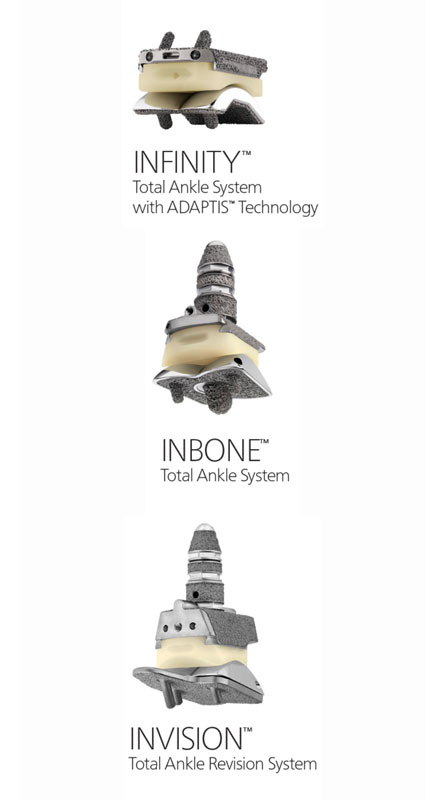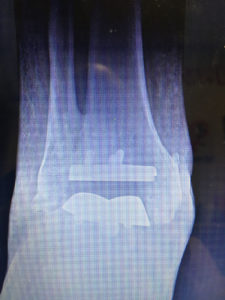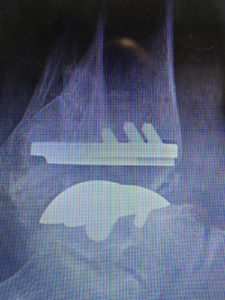29 Jun TAR Total Ankle Replacement
TAR

A total ankle replacement (TAR), or ankle arthroplasty, allows people who suffer from chronic ankle pain to maintain a functioning ankle without the severely limiting chronic pain. When the tissues and structures of the ankle joint are damaged, they hurt. If the damage is significant enough, the best option is to remove the joint entirely. In total ankle replacement surgery, the ankle joint is realigned and the joint surfaces are removed and replaced with prosthetic components.
The artificial components are generally made of metal, medical-grade titanium, and plastic, polyethylene materials. If you suffer from chronic ankle pain, you may be a candidate for total ankle replacement. After you recover from a total ankle replacement, you should regain most of your previous level of mobility and enjoy a much more pain-free lifestyle.
My ankle has hurt for a long time, now what?
There is a lot going on in and around the ankle joint. It is important to understand that the pain is actually coming from the ankle itself. Getting the right diagnosis is key before deciding to completely replace the ankle. X-rays and ultrasound are general imaging modalities used in diagnosing ankle arthritis. MRIs, CT scans, known as advanced imaging modalities, are really helpful in ruling out other potential causes of chronic ankle pain that may be lurking. A diagnostic injection into the ankle joint helps to prove the source of the pain as well. There is no better way to diagnose the extent of the damage in the ankle than by looking at it directly (arthroscopy of the ankle).

This is done by inserting a camera into the ankle and recording the findings with pictures. Usually patients are asleep while pictures are being taken.
Why Do I Need a Prosthetic Ankle?
There are several main reasons why surgeons recommend that patients have a total ankle replacement, including the following:
Advanced Arthritis
Our larger joints in the lower extremities have shock absorbers known as cartilage. Healthy cartilage allows the joint to move and glide and protect the bones from grinding on one another as we walk. Severe osteoarthritis, or cartilage damage, is a common reason that patients have the joint replaced. With end stage osteoarthritis, the cartilage is nearly completely degenerated, leaving bone on bone grinding within the joint. Swelling and inflammation about the ankle causes stiffness and pain further inhibiting the patient from activity. The ankle joint may even lock up. When surgeons speak of replacing the ankle, they are actually removing the damaged cartilage and implanting metal and plastic in its place.
Similarly, debilitating rheumatoid arthritis places you at risk of needing an ankle replacement. The disorder may erode the bone in the ankle joint and cause deformity and disability.
Chronic Ankle Pain
Chronic pain that settles in the ankle may be a sign that the ankle needs replacing. The pain may be the result of a sports injury or trauma caused by an accident or a fall. Usually extensive trauma leads to damage that can obviously be identified on an X-Ray. Again, it is really important that a correct diagnosis is made before considering a total ankle replacement.
Disability
Limited mobility and the loss of the ankle’s range of motion are also signs that may necessitate an ankle replacement when other treatments fail to work. Physical therapy, medications, injections, bracing, other types of surgeries are all examples of other treatments that can be attempted prior to having your ankle replaced.
Ankle Instability
It only takes one. You may have heard someone say, “I have weak ankles.” Forty percent of the time, a single ankle sprain causes the ligaments to become torn and loosened. The body has no way to naturally tighten them back again, which creates a sensation of the ankle feeling weak. A common misconception, especially in sports, is that you just have to live with “weak ankles.” An unstable, “weak,” ankle creates more opportunities for multiple recurrent ankle sprains down the road. When the ankle joint becomes loose, the ligaments around the joint can no longer protect the ankle joint from excessive motion. With the joint functioning out of alignment, the extra motion leads to the cartilage bruising and softening. The cartilage will eventually die off from the repetitive wear and tear.
Fracture
Severe ankle fractures that heal improperly can lead to a lack of proper range of motion in the ankle joint. Having a total ankle replacement may be the ideal solution to fix this problem and restore capability.
Who should not have an ankle replacement?
Every person is a unique individual. Activity and lifestyle play a major role in decision making for a total ankle replacement. Some chronic illnesses can increase the risk of failure or implant rejection. Uncontrolled diabetes and severe obesity make individuals poor candidates for total ankle replacements.
Total ankle replacement is not recommended if you have:
- An active or prior deep infection in the ankle joint
- Inadequate bone to support the implants
- Neuromuscular disease that impairs muscles, resulting in poor muscle tone and function in the ankle
- Charcot neuropathy (loss of sensation in foot and ankle)
- Severe ankle deformity
- Poor musculature quality at the surgical site
How is the surgery performed?
Ankle surgeons typically perform total ankle replacements using general anesthesia with a nerve block around the knee for postoperative pain control. The doctor places a tourniquet around the thigh to help control bleeding and improve visualization during surgery. The surgeon makes an incision in the front or side of the ankle depending on the type of implant used. Prior to the surgery, a 3D printed replica of your ankle is created for exact placement of the cutting guides for the metal implants. X-ray is then used to confirm accurate placement of the cutting guide. The surgeon cuts the bones, which allows for the placement of metal and plastic components to recreate the ankle joint. The ankle is taken through a range of motion. If the range of motion is tight then some tissues around the ankle are loosened. Often the Achilles tendon is tight and needs to be lengthened. If ligaments around the ankle are loose, they are subsequently tightened. Then the surgeon closes the incisions with sutures or staples, and the ankle is placed in a well-padded splint.
What happens after surgery?
After surgery, you will typically spend 1 to 2 nights in the hospital. After you go home, you are expected to keep your foot elevated to reduce swelling and improve wound healing. You will stay off your foot completely for 3 to 4 weeks. Using a knee scooter or walker is extremely helpful for getting around. You can bear weight as tolerated in a walking boot for another 3 to 4 weeks. Typically, after 6 weeks, you can return to a regular shoe and begin physical therapy to work on range of motion and strengthening the ankle. Patients often ask why they cannot walk on their ankle for a period after surgery. The skin around the ankle is thinner than in other joints like the knee and hip. Too much motion early on can cause the skin to weaken and prevent the incision from healing. Ultimately this leads to serious infections and more surgeries.
What are the risks of the surgery?
Risks of any surgery include the following:
- Infection
- excessive blood loss
- complications associated with anesthesia
- Wound problems- especially in smokers
With ankle replacements, new stresses on the bone can cause it to fracture. Implant failure can result if the bone fails to heal to the metal components. As in all total joint replacements, the plastic component between the metal device can wear out, which could result in loosening of the implant from the bone. This typically requires revision surgery to replace the implants for bony ingrowth. If the implant does fail, it can be removed and the ankle joint can then be fused using a bone graft.
What are the long term outcomes?
With the advancement of technology, there has never been a better time to have a total ankle replacement. Implants in the ankle last up to ten years or more. Accuracy of implant placement has improved dramatically. This accuracy allows most patients to return to their regular activities after total ankle replacement. Though, surgeons generally recommend lower impact activities after ankle replacement to prolong the life of the implant.



